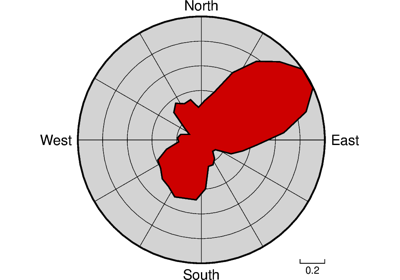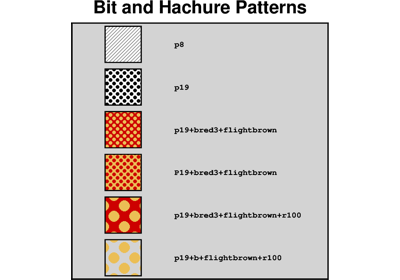pygmt.Figure.rose
- Figure.rose(data=None, length=None, azimuth=None, frame=False, region=None, verbose=False, panel=False, transparency=None, perspective=False, incols=None, **kwargs)
Plot a polar histogram (rose, sector, windrose diagrams).
Takes a matrix, (length,azimuth) pairs, or a file name as input and plots windrose diagrams or polar histograms (sector diagram or rose diagram).
Must provide either
dataorlengthandazimuth.Options include full circle and half circle plots. The outline of the windrose is drawn with the same color as MAP_DEFAULT_PEN.
Full GMT docs at https://docs.generic-mapping-tools.org/6.6/rose.html.
Aliases:
A = sector
C = cmap
D = shift
Em = vectors
F = no_scale
G = fill
I = inquire
JX = diameter
L = labels
M = vector_params
Q = alpha
S = norm
T = orientation
W = pen
Z = scale
b = binary
d = nodata
e = find
h = header
w = wrap
B = frame
R = region
V = verbose
c = panel
i = incols
p = perspective
t = transparency
- Parameters:
data (
str|PathLike|dict|ndarray|DataFrame|Dataset|GeoDataFrame|None, default:None) – Pass in either a file name to an ASCII data table, a 2-Dnumpy.ndarray, apandas.DataFrame, anxarray.Datasetmade up of 1-Dxarray.DataArraydata variables, or ageopandas.GeoDataFramecontaining the tabular data. Use parameterincolsto choose which columns are length and azimuth, respectively. If a file with only azimuths is given, useincolsto indicate the single column with azimuths; then all lengths are set to unity (seescale="u"to set actual lengths to unity as well).length/azimuth (float or 1-D arrays) – Length and azimuth values, or arrays of length and azimuth values.
orientation (bool) – Specify that the input data are orientation data (i.e., have a 180 degree ambiguity) instead of true 0-360 degree directions [Default is 0-360 degrees]. We compensate by counting each record twice: First as azimuth and second as azimuth +180. Ignored if
regionis given as (-90, 90) or (0, 180).region (str or list) – r0/r1/az0/az1 or [r0, r1, az0, az1]. Required if this is the first plot command. Specify the
regionof interest in (r, azimuth) space. Here, r0 is 0 and r1 is the maximal length in units. For az0 and az1, specify either (-90, 90) or (0, 180) for half circle plot or (0, 360) for full circle.diameter (str) – Set the diameter of the rose diagram. If not given, then we default to a diameter of 7.5 cm.
sector (float or str) – Give the sector width in degrees for sector and rose diagram. Default
0means windrose diagram. Append +r to draw rose diagram instead of sector diagram (e.g."10+r").norm (bool) – Normalize input radii (or bin counts if
sectoris used) by the largest value so all radii (or bin counts) range from 0 to 1.frame (str) – Set map boundary frame and axes attributes. Remember that x here is radial distance and y is azimuth. The y label may be used to plot a figure caption. The scale bar length is determined by the radial gridline spacing.
scale (float or str) – Multiply the data radii by scale. E.g., use
scale=0.001to convert your data from m to km. To exclude the radii from consideration, set them all to unity withscale="u"[Default is no scaling].fill (str) – Set color or pattern for filling sectors [Default is no fill].
cmap (str) – Give a CPT. The r-value for each sector is used to look-up the sector color. Cannot be used with a rose diagram.
pen (str) – Set pen attributes for sector outline or rose plot, e.g.
pen="0.5p". [Default is no outline]. To change pen used to draw vector (requiresvectors) [Default is same as sector outline] use e.g.pen="v0.5p".labels (str) – wlabel,elabel,slabel,nlabel. Specify labels for the 0, 90, 180, and 270 degree marks. For full-circle plot the default is
"West,East,South,North"and for half-circle the default is"90W,90E,-,0". A"-"in any entry disables that label (e.g.labels="W,E,-,N"). Uselabels=""to disable all four labels. Note that the GMT_LANGUAGE setting will affect the words used.no_scale (bool) – Do NOT draw the scale length bar (
no_scale=True). Default plots scale in lower right corner providedframeis used.shift (bool) – Shift sectors so that they are centered on the bin interval (e.g., first sector is centered on 0 degrees).
vectors (str) – mode_file. Plot vectors showing the principal directions given in the mode_file file. Alternatively, specify
vectorsto compute and plot mean direction. Seevector_paramsto control the vector attributes. Finally, to instead save the computed mean direction and other statistics, usevectors="+wmode_file". The eight items saved to a single record are: mean_az, mean_r, mean_resultant, max_r, scaled_mean_r, length_sum, n, sign@alpha, where the last term is 0 or 1 depending on whether the mean resultant is significant at the level of confidence set viaalpha.vector_params (str) – Used with
vectorsto modify vector parameters. For vector heads, append vector head size [Default is 0, i.e., a line]. See https://docs.generic-mapping-tools.org/6.6/rose.html#vector-attributes for specifying additional attributes. Ifvectorsis not given and the current plot mode is to draw a windrose diagram then usingvector_paramswill add vector heads to all individual directions using the supplied attributes.Set the confidence level used to determine if the mean resultant is significant (i.e., Lord Rayleigh test for uniformity) [Default is
alpha=0.05]. Note: The critical values are approximated [Berens, 2009] and requires at least 10 points; the critical resultants are accurate to at least 3 significant digits. For smaller data sets you should consult exact statistical tables.Berens, P., 2009, CircStat: A MATLAB Toolbox for Circular Statistics, J. Stat. Software, 31(10), 1-21, https://doi.org/10.18637/jss.v031.i10.
verbose (bool or str) – Select verbosity level [Full usage].
i|o[ncols][type][w][+l|b]. Select native binary input (using
binary="i") or output (usingbinary="o"), where ncols is the number of data columns of type, which must be one of:c: int8_t (1-byte signed char)
u: uint8_t (1-byte unsigned char)
h: int16_t (2-byte signed int)
H: uint16_t (2-byte unsigned int)
i: int32_t (4-byte signed int)
I: uint32_t (4-byte unsigned int)
l: int64_t (8-byte signed int)
L: uint64_t (8-byte unsigned int)
f: 4-byte single-precision float
d: 8-byte double-precision float
x: use to skip ncols anywhere in the record
For records with mixed types, append additional comma-separated combinations of ncols type (no space). The following modifiers are supported:
w after any item to force byte-swapping.
+l|b to indicate that the entire data file should be read as little- or big-endian, respectively.
Full documentation is at https://docs.generic-mapping-tools.org/6.6/gmt.html#bi-full.
panel (
int|Sequence[int] |bool, default:False) –Select a specific subplot panel. Only allowed when used in
Figure.subplotmode.Trueto advance to the next panel in the selected order.index to specify the index of the desired panel.
(row, col) to specify the row and column of the desired panel.
The panel order is determined by the
Figure.subplotmethod. row, col and index all start at 0.nodata (str) – i|onodata. Substitute specific values with NaN (for tabular data). For example,
nodata="-9999"will replace all values equal to -9999 with NaN during input and all NaN values with -9999 during output. Prepend i to the nodata value for input columns only. Prepend o to the nodata value for output columns only.find (str) – [~]“pattern” | [~]/regexp/[i]. Only pass records that match the given pattern or regular expressions [Default processes all records]. Prepend ~ to the pattern or regexp to instead only pass data expressions that do not match the pattern. Append i for case insensitive matching. This does not apply to headers or segment headers.
header (str) –
[i|o][n][+c][+d][+msegheader][+rremark][+ttitle]. Specify that input and/or output file(s) have n header records [Default is 0]. Prepend i if only the primary input should have header records. Prepend o to control the writing of header records, with the following modifiers supported:
+d to remove existing header records.
+c to add a header comment with column names to the output [Default is no column names].
+m to add a segment header segheader to the output after the header block [Default is no segment header].
+r to add a remark comment to the output [Default is no comment]. The remark string may contain \n to indicate line-breaks.
+t to add a title comment to the output [Default is no title]. The title string may contain \n to indicate line-breaks.
Blank lines and lines starting with # are always skipped.
incols (
int|str|Sequence[int|str] |None, default:None) –Specify data columns for primary input in arbitrary order. Columns can be repeated and columns not listed will be skipped [Default reads all columns in order, starting with the first (i.e., column 0)].
For a sequence: specify individual columns in input order (e.g.,
incols=(1, 0)for the 2nd column followed by the 1st column).For a string: specify individual columns or column ranges in the format start[:inc]:stop, where inc defaults to 1 if not specified, with columns and/or column ranges separated by commas (e.g.,
incols="0:2,4+l"to input the first three columns followed by the log10-transformed 5th column). To read from a given column until the end of the record, leave off stop when specifying the column range. To read trailing text, add the column t. Append the word number to t to ingest only a single word from the trailing text. Instead of specifying columns, useincols="n"to simply read numerical input and skip trailing text. Optionally, append one of the following modifiers to any column or column range to transform the input columns:+l to take the log10 of the input values.
+d to divide the input values by the factor divisor [Default is 1].
+s to multiple the input values by the factor scale [Default is 1].
+o to add the given offset to the input values [Default is 0].
perspective (
float|Sequence[float] |str|bool, default:False) –Select perspective view and set the azimuth and elevation of the viewpoint.
Accepts a single value or a sequence of two or three values: azimuth, (azimuth, elevation), or (azimuth, elevation, zlevel).
azimuth: Azimuth angle of the viewpoint in degrees [Default is 180, i.e., looking from south to north].
elevation: Elevation angle of the viewpoint above the horizon [Default is 90, i.e., looking straight down at nadir].
zlevel: Z-level at which 2-D elements (e.g., the map frame) are drawn. Only applied when used together with
zsizeorzscale. [Default is at the bottom of the z-axis].
Alternatively, set
perspective=Trueto reuse the perspective setting from the previous plotting method, or pass a string following the full GMT syntax for finer control (e.g., adding+wor+vmodifiers to select an axis location other than the plot origin). See https://docs.generic-mapping-tools.org/6.6/gmt.html#perspective-full for details.transparency (float) – Set transparency level, in [0-100] percent range [Default is
0, i.e., opaque]. Only visible when PDF or raster format output is selected. Only the PNG format selection adds a transparency layer in the image (for further processing).wrap (str) –
y|a|w|d|h|m|s|cperiod[/phase][+ccol]. Convert the input x-coordinate to a cyclical coordinate, or a different column if selected via +ccol. The following cyclical coordinate transformations are supported:
y: yearly cycle (normalized)
a: annual cycle (monthly)
w: weekly cycle (day)
d: daily cycle (hour)
h: hourly cycle (minute)
m: minute cycle (second)
s: second cycle (second)
c: custom cycle (normalized)
Full documentation is at https://docs.generic-mapping-tools.org/6.6/gmt.html#w-full.

